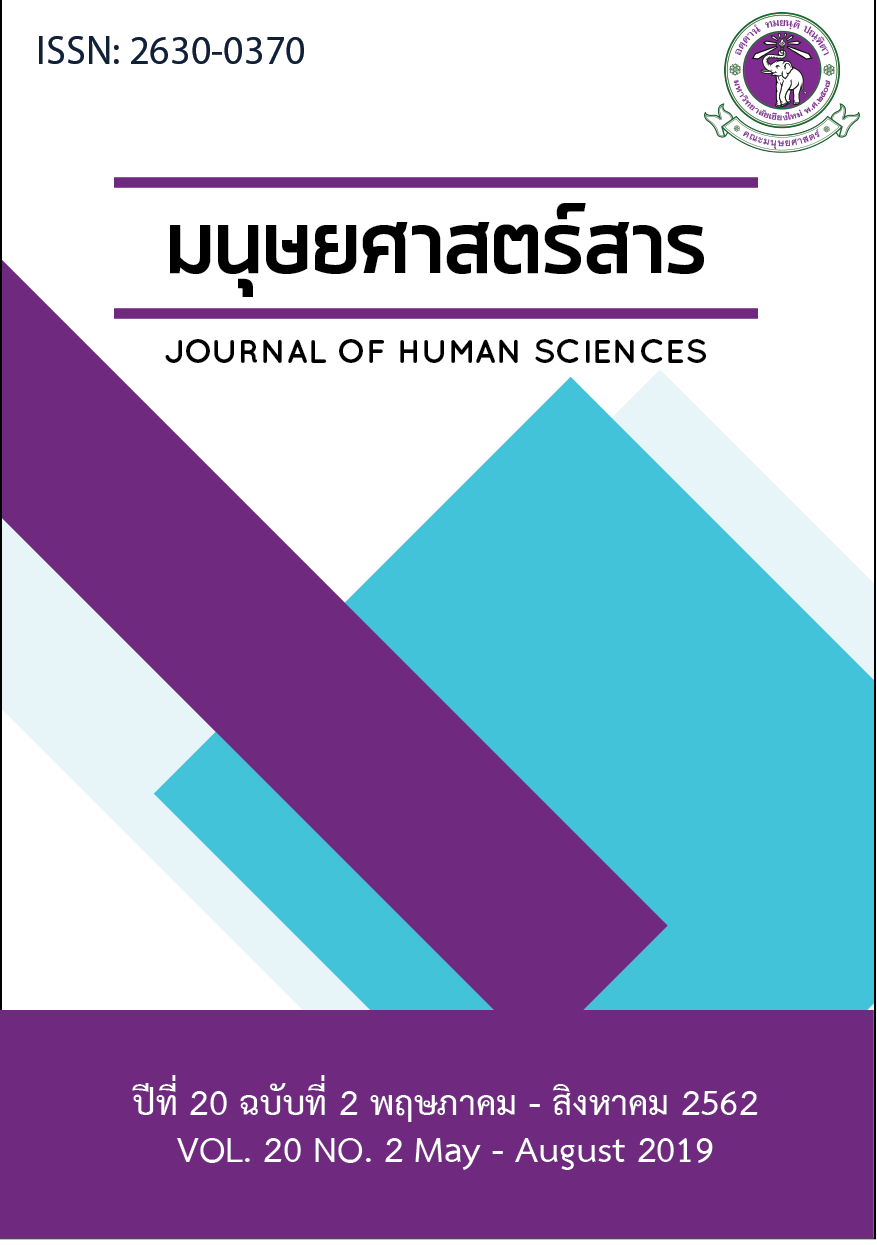คำสลับพยางค์ในภาษาไทยมาตรฐานและภาษาไทยถิ่น
Main Article Content
บทคัดย่อ
งานวิจัยเรื่องนี้มีวัตถุประสงค์เพื่อรวบรวมคำสลับพยางค์ในพจนานุกรมภาษาไทยมาตรฐานและภาษาไทยถิ่น รวมถึงวิเคราะห์และเปรียบเทียบจำนวนคำและลักษณะการใช้คำสลับพยางค์ในพจนานุกรมภาษาไทยมาตรฐานและภาษาไทยถิ่น โดยพจนานุกรมภาษาไทยมาตรฐานรวบรวมจากพจนานุกรมฉบับราชบัณฑิตยสถาน จำนวน 3 เล่ม ได้แก่ พจนานุกรม พ.ศ. 2554 พจนานุกรมคำใหม่เล่ม 1-2 และ เล่ม 3 รวมถึงพจนานุกรมฉบับมติชน และ “คลังคำ” รวมทั้งสิ้น 5 เล่ม โดยนำมาวิเคราะห์และเปรียบเทียบกับพจนานุกรมภาษาไทยถิ่นรวบรวมจากพจนานุกรมภาษาไทยถิ่นเหนือ จำนวน 2 เล่ม ได้แก่พจนานุกรมล้านนา-ไทย ฉบับแม่ฟ้าหลวง และพจนานุกรมภาษาล้านนา พจนานุกรมภาษาไทยถิ่นอีสาน จำนวน 2 เล่ม ได้แก่ สารานุกรมภาษาอีสาน-ไทย-อังกฤษ และพจนานุกรมภาษาถิ่นภาคตะวันออกเฉียงเหนือ พจนานุกรมภาษาไทยถิ่นใต้ จำนวน 2 เล่ม ได้แก่ พจนานุกรมภาษาถิ่นใต้ พุทธศักราช 2525 และพจนานุกรมภาษาถิ่นใต้พุทธศักราช 2550 รวมทั้งสิ้น 6 เล่ม โดยงานวิจัยนี้ใช้ทฤษฎีการสร้างคำของ George Yule และหลักการสร้างคำในภาษาไทยเพื่อวิเคราะห์และเปรียบเทียบลักษณะการใช้คำสลับพยางค์ในพจนานุกรมฉบับต่างๆ ดังกล่าว ผลการศึกษาพบว่า คำสลับพยางค์มีจำนวนทั้งสิ้น 3,953 คำ แบ่งเป็นพจนานุกรมภาษาไทยมาตรฐานจำนวน 2,840 คำ คิดเป็นร้อยละ 71.89 และพจนานุกรมภาษาไทยถิ่นจำนวน 1,113 คำ คิดเป็นร้อยละ 28.11 แสดงให้เห็นว่า จำนวนคำสลับพยางค์ในภาษาไทยมาตรฐานมีมากกว่าภาษาไทยถิ่น 1,727 คำ คิดเป็นร้อยละ 43.78 ด้านลักษณะการใช้คำสลับพยางค์ในภาษาไทยมาตรฐานและภาษาไทยถิ่นปรากฏทั้งหมด 6 ลักษณะ จำนวนทั้งสิ้น 849 คู่ ทั้งนี้การใช้ คำสลับพยางค์คู่ในภาษาไทยมาตรฐานกับคำสลับพยางค์ไม่ปรากฏในภาษาไทยถิ่น มีจำนวนมากที่สุด 416 คู่ คิดเป็นร้อยละ 49.00 ผลการวิจัยครั้งนี้แสดงให้เห็นว่า จำนวนและลักษณะการใช้คำสลับพยางค์ในภาษาไทยมาตรฐานปรากฏมากกว่าคำสลับพยางค์ในภาษาไทยถิ่น ซึ่งเป็นผลมาจากระบบเสียงและระบบการเขียน ระบบคำและระบบความหมาย
Article Details
เอกสารอ้างอิง
Chaing Mai Rajabhat University, Institute of Language, Art and Culture. (2007). Photchananukrom phasa lanna (phim khrang thi 2) [Lanna Language Dictionary (2nd ed.)] Chiang Mai: Seangsin.
Keawkhieo, Y. (2008). kansưksa priapthiap khamprasom phasa Thai mattrathan kap phasa Thai thin nưa [A comparative Study of Compound Words in Standard Thai and Northern Thai Dialect]. Journal of Thai Language and Thai Culture Kasetsart University, 3(2), 139-152.
Khamkhoksung, C. (2010). khamson nai phasa thin Khorat [Compound Words in Korat Thai Dialect] (Independent Study of Master of education, Naresuan University).
Matichon. (2004). photchananukrom chabap mati chon [Matichon Dictionary of Thai Language]. Bangkok: Matichon.
Nakhon Si Thammarat Rajabhat University. (2008). photchananukrom phasa thin tai Phutthasakkarat songphanharoihasip (phim khrang thi 5) [Southern Thai Dialect Dictionary 2550 B.E. (5th ed.)]. Bangkok: My Media.
Naksakul, K. (2008). rabop siang phasa Thai (phim khrang thi 6) [Thai Phonology (6th ed.)]. Bangkok: Chulalongkorn University.
Office of the National Culture Commission. (n.d.). photchananukrom phasa thin phak tawan ok chiang nưa [North Eastern Thai Dialect Dictionary]. Bangkok: Arun.
Phanthumetha, N. (2016). khlang kham (phim khrang thi 7) [Word Source (7th ed.)]. Bangkok: Amarin.
Phinthong, P. (1989). saranukrom phasa Isan - Thai - Angkrit [Isaan-Thai-English Dictionary]. Ubon Ratchathani: Siritham.
Phraya Oupakitsinlapasarn. (1996). lak phasa Thai [Principle of Thai language]. Bangkok: Thai Watanapanich.
Phummuang, S. (2007). kan wikhro khrongsang læ khwammai khong khamprasom nai photchananukrom chabap ratchabanthittayasathan Pho.So. songphanharoisisipsong [An Analysis of Structures and Meaning of Compounds in the Standard Thai Dictionary 1999] (Thesis of Master of education, Naresuan University).
Prasithrathsint, A. (2005). phasa nai sangkhom Thai: khwamlaklai kan plianplæng læ kanphatthana [Language in Thai society: diversity change, and development]. Bangkok: Chulalongkorn University.
Royal Institute of Thailand. (2011). photchananukrom kham mai lem sam [Royal Institute Dictionary of New Words Volume III]. Bangkok: Union Ultraviolet.
Royal Institute of Thailand. (2013). photchananukrom chabapratchabanthittayasathan Pho.So. songphanharoihasipsi [Royal Institute Dictionary 2554 B.E.]. Bangkok: Siriwatthana Interprint.
Royal Institute of Thailand. (2014). photchananukrom kham mai lem nung-song [Royal Institute Dictionary of New Words Volume I & II]. Bangkok: Nameebooks.
Rungruangsri, U. (2004). photchananukrom lanna - Thai chabap mæ fa luang [Lanna-Thai Dictionary: Mae Fah Luang Edition]. Chiang Mai: Mingmuang.
Srinakharinwirot University, Institute for Southern Thai Studies. (1992). photchananukrom phasa thin tai Phutthasakkarat songphanharoiyisipha (phim khrang thi 3) [Southern Thai Dialect Dictionary 2525 B.E. (3rd ed.)]. Bangkok: Amarin.
Thonglor, K. (2007). lak phasa Thai [Principle of Thai language]. Bangkok: Ruamsarn.
Yodmongkhon, K. (1999). kansưksa siang ra nai phasa Thai chœng prawat [A Historical Study of R in Thai] (Thesis of Doctor of Philosophy Linguistics, Mahidol University).
Yule, G. (1985). The Study of Language. Cambridge: Cambridge University Press.


